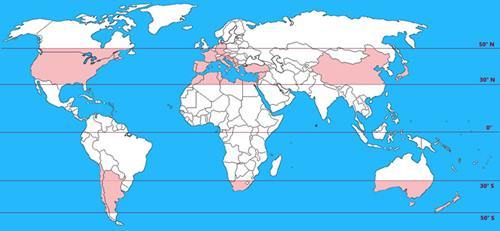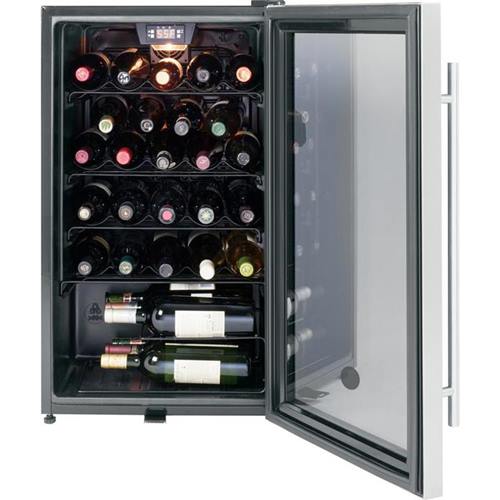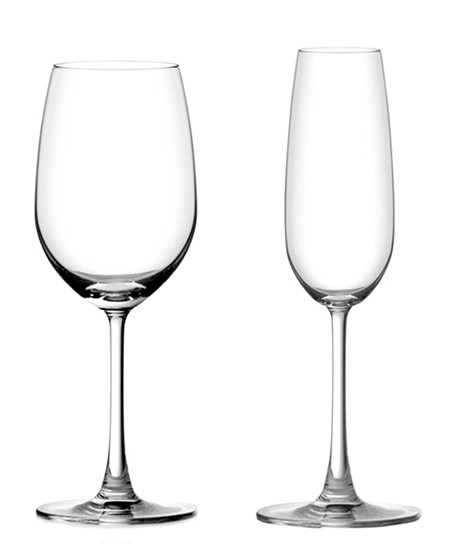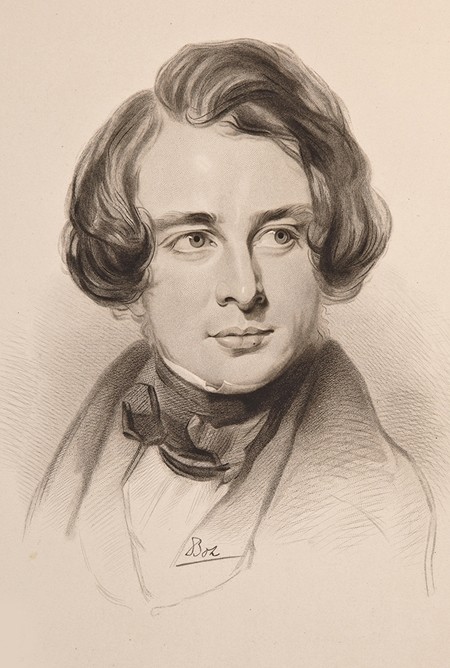 |
|
 |
|
Wine World
by Colin Kaye |
|
|
|
Changing Latitudes

Map showing 30°-50° latitudes.
If you wander through the wine section
of a typical supermarket you might get the impression that wine comes from
all over the world. But you’d be wrong. The bulk of the world’s wine
originates from grapes grown between 30 and 50 degrees of latitude in both
the Northern and Southern hemispheres. The Northern Hemisphere is by far the
larger wine producer because this band covers much more land, whereas the
Southern 30-50 degree band is mostly over oceans.
But perhaps you have forgotten what
“latitude” means, especially if your geography is a bit hazy. So let me
explain. On a map or globe of the Earth, latitude is shown by imaginary
horizontal lines like hula hoops around the surface from the equator to the
two poles. On a map, like the one shown here, they appear as straight lines.
They’re sometimes called “parallels” because they run parallel to the
equator which is the starting point for measuring latitude so it’s
considered as zero degrees. Thailand is comparatively near the equator and
Pattaya lies 12° North. One degree of latitude is around 69 miles (or 110
kms) so Chiang Mai is almost 19° N. London is about 51.5° N whereas on the
opposite side of the world, Sydney is about 35° South (usually shown as
-35°). This of course is within the southern grape-growing comfort zone.
The vertical lines on a map or globe
indicate longitude and knowing both these values you can pin-point anywhere
on the globe. This is partly how your GPS device works. Surprisingly
perhaps, the concepts of latitude and longitude have been known since
ancient times. Mariners of old could determine their latitude from the
position of the sun, or at night from the positions of the stars. Finding
longitude however, proved a spectacularly difficult problem. In 1707 the
British Government offered a reward of twenty thousand pounds (equivalent to
four million dollars in 2020) to anyone who could devise an accurate way of
accurately determining longitude. But that’s another story. And a good one,
too.
But back to wine. Fifty years ago, it
was assumed that wine grapes would grow only between 30 and 50
degrees and nowhere else. We know now that grapes can grow far beyond this
range in places like India, Vietnam, Indonesia and Namibia. In the 1980s
Thailand pioneered wine production in a narrow band between 14-18°N. Today
several Thai wineries are producing award-winning wines from grapes grown at
these latitudes.
Latitude is only part of a complex
equation. The wine in your glass is the result of several other factors such
as climate, weather, soil, terrain and wine-making techniques. These are
often described as terroir (tair-WAH) a convenient French word
for which there is no exact English equivalent. Merlot grown in Bordeaux
doesn’t taste the same as Merlot grown in the Napa Valley because the
terroir is different. Climate is critical too and you’ll hear
expressions like “cool” and “hot” climate wines. Generally speaking, cool
climate wines tend to be light bodied with low alcohol, crisp acidity and
bright fruit flavors. Hot climate wines are usually fuller bodied with
higher alcohol, softer acidity and more lush fruit flavours. So you see,
your personal choice of wine might depend largely on climate.
Confused about climate and weather? The
American writer Robert A. Heinlein has the answer: “Climate is what you
expect, weather is what you get.” Few would disagree that our climate is
changing and this has an impact on viticulture. Eric Asimov is the wine
columnist for the New York Times. Last year he wrote, “Grape growers
especially have been noting profound changes in weather patterns since the
1990s. In the short term, some of these changes have actually benefited
certain regions.” He is right. While some wine areas have recently
experienced drought, heat waves and unexpected hail, others have been more
fortunate. For example, top quality English sparkling wine was unheard of in
the 1980s but today’s warmer climate is allowing English wine-makers to
produce world-class sparklers using the méthode champenoise. Not
surprisingly, new vineyards are being planted with enthusiasm in England’s
southern counties.
Climate change is providing
opportunities for more northerly regions to develop a wine industry and
grapes are now being planted in Belgium, Denmark, Norway, Sweden and even
Finland. Thirty years ago, only a lunatic would have contemplated planting
grapes at 59° N.
Winemakers have another problem
relating to climate change. Higher temperatures cause grapes to ripen
earlier. The sugar in the grapes turns into alcohol too quickly before the
all-important phenols have had sufficient time to develop. These phenols
include several hundred chemical compounds that enhance the colour, taste
and mouth-feel. Wine-makers now have to decide whether to harvest grapes
early, producing wine with acceptable alcohol levels but with less interest
and complexity. The alternative is to leave the grapes on the vine and wait
for the development of the phenolic compounds, risking wine which is too
high in alcohol.
And in case you’re wondering, the wine
industry produces only about 0.1 percent of global carbon emissions. Now if
you ask me that’s welcome news. Perhaps we should open another bottle.
|

|
Stone cold

GE® Brand Wine Center.
Down at the watering
hole the other night, the subject of wine came up again. One of my
companions quoted that tired old cliché that he prefers “red wine at room
temperature”. I resisted the temptation to make an issue of it, but a
moment’s thought reveals that the statement is nonsense. For a start, it
implies that all red wine should be served at the same temperature which is
simply not true. More importantly the temperature of a room depends on many
variables, especially in this part of the world. As I am typing this, the
temperature in my study - with all the windows open is about 33°C (91° F).
Only a lunatic would drink wine as warm as that.
Wine temperature is critical. And
before you protest about this being a subjective matter, remember that we
are not talking about personal taste here, but how to taste the wine at
its best. Experts agree that every wine has its optimum serving
temperature. One of the biggest mistakes people make is drinking wine too
warm, or more usually in these parts, too cold. Even the cheapest plonk
taste better at the appropriate temperature.
Generally speaking, young or
light-bodied wines taste better at lower temperatures whereas full-bodied
wines are at their best several degrees higher. The “body” or “boldness” of
the wine is the result of several factors including grape variety, climate,
vintage, alcohol level and tannins. In case you’re wondering, tannins occur
naturally in vines and in oak barrels and have a distinctive taste that
makes your tongue feel dry. On the positive side, they add body and
character and they’re most noticeable in red wines.
Right then, let’s be a bit more
specific and start with some popular reds. If a full-bodied red is served
too cold the tannins taste rough and unpleasant, the aromas lie hidden and
the flavour feels unyielding. On the other hand, nothing ruins a red wine
more quickly than serving it too warm. Full-bodied reds such as Cabernet
Sauvignon, Syrah and Malbec are best at 16-17°C (61-63°F). You can include
virtually all Bordeaux, Burgundy or Rhône in this category. In cold-climate
areas such as Northern Europe, reds of this type are normally served at the
prevailing ambient temperature. Medium-bodied reds such as Chianti and
Valpolicella are best a little cooler at 13-15°C (55-59°F) and very light
reds such as Bardolino, Lambrusco or Beaujolais taste freshest when they’re
distinctly cool at 12°C (54°F). Rosé wines should always be well-chilled
around 8°C (46°F).
White wines also range from full-bodied
to light-bodied but unlike reds, they can also be sweet or dry. Whites
invariably taste better when they’re chilled because warm white wine always
feels flabby and dull. Full-bodied whites such hot-climate Chardonnay should
be slightly chilled at 9-10°C (48-50°F) and lighter whites such as Orvieto,
Pinot Grigio or Soave well-chilled at 8°C (47°F). Champagne and Prosecco
along with many sweet wines taste best when they are decidedly cold at about
7°C (45°F) which is pretty well straight out of the fridge. Sherry is
technically a white wine and it’s still a popular drink in the UK though
almost everyone makes the mistake of serving it too warm. In its home
country of Spain, it’s always well chilled to bring out the freshness. Don’t
worry about serving white wine too cold, because in our tropical climate
it’ll warm up all too quickly.
You’d be surprised at how rapidly this
occurs. As an experiment, I checked the temperature of a Chilean Chardonnay
straight out of the fridge. It was 3°C (37°F) and too cold for drinking.
Having sloshed the wine into a decanter to aerate it, I then poured a
sample. During this process, which took less than a couple of minutes the
wine’s temperature shot up to 10°C (50°F) which as luck would have it, is
just about right for Chilean Chardonnay. But then the glass of wine was left
unattended for five minutes during which time the temperature increased to
an amazing 15°C (59°F); far too warm to taste at its best. It was heating up
at one degree Celsius - or roughly two degrees Fahrenheit - every sixty
seconds. At a social occasion, the wine could be too warm before you
reach the end of the glass, especially there’s the usual chok dee
routine to endure before every swig. I should add that during my
not-too-scientific experiment in the kitchen, the air-conditioner was off,
because being half Scottish I tend to avoid reckless spending. In an
air-conditioned room of course, the rise in temperature would be a little
slower.
You can’t really check the temperature
by sticking your finger in the glass, though with practice you can become
quite proficient at estimating temperature. If you want to get it
consistently right, buy a wine or cooking thermometer. Lazada has a good
selection, including some cheap LCD bracelets that conveniently fit around
bottles.
Although different wines should be
served at different temperatures, all wines should be stored at
the same constant temperature which is about 13°C (55°F). Unless you can
afford an expensive wine storage cooler it’s probably unrealistic in this
country to store wine at home. The sensible solution is probably to buy wine
when you need it then stick it in the fridge before the bottle is opened.
Then let the bottle rest in an ice-bucket containing water (and some ice if
necessary) at roughly the right temperature. You can help white wine by
serving it in cold glasses, but not so cold that your guests drop them in
shock.
|

|
Glass Conscious

Madison red wine glass (L) and Champagne flute
from Ocean.
At a push, you could
probably drink wine out of a plastic mug, but you’d lose most of the aroma
and a good deal of the pleasure. Wine always tastes best out of a
well-designed glass but they come in a bewildering variety of shapes and
sizes. The distinguished Austrian firm of Riedel (REE-dull) was
established in the same year that Mozart was born and it has revolutionized
glassware by customizing the shape of wine glasses to a particular type of
wine. There’s a range of glasses for Cabernet Sauvignon, another type for
Shiraz, another for Riesling and so on. Wine expert Robert Parker considers
them the finest available. “The effect of these glasses on fine wine is
profound,” he writes, “I cannot emphasize enough what a difference they
make.” But quality doesn’t come cheap. Even one of Riedel’s cheapest glasses
can set you back 2,000 baht. And that’s just for one of them. Needless to
say, these are products for wine professionals and top-class restaurants.
Most of us usually have to settle for something a little more modest.
Even so, if you enjoy a variety of
different wines you really need three or four different types of glass: (1)
a medium-sized one for everyday plonk, (2) a larger one for quality wines,
and (3) a tall one for sparkling wines. You can safely forget about serving
white wine in a smaller glass, for a decently designed glass will do for
both red and white. If you drink Sherry a small copita is a useful
addition.
There are four main issues to consider:
shape, comfort, transparency and size. You may also be concerned about
price, so don’t buy glasses that you can’t afford to break. A tulip-shaped
glass is best, because it concentrates the aroma near the rim. The glass
should be well-balanced and not uncomfortably heavy, with a thin stem. The
rim should be wide enough to get your nose inside. A plain, transparent
glass is best because any form of colour or decoration is distracting. As to
size, it rather depends on the quality of the wine. Regardless of size, I’d
recommend the glasses produced by the Thai company Ocean Glass. It produces
an extensive range of wine glasses which are good value and widely
available.
For ordinary table wine the Ocean
Duchess range is fine. The 255ml (9oz) red wine glass is 19cm (7.50 in)
high and a pack of two is about 325 baht. If you crave something a bit more
classy and money is no object, you might be interested in Ocean’s superb
range of Lucaris crystal glasses, some of which are varietal
specific.
Quality wines require larger glasses
because you need to swirl the wine around to release the complex aroma. This
is why the glass shouldn’t be more than about a third full. The Ocean 425ml
(15oz) Madison red wine glass is a large elegant design standing at
22cm (8.6 in). I always use this for wine tasting and a pack of two costs
around 325 baht. If you prefer something a little cheaper and more compact,
Ocean’s Lexington range might meet your needs.
For sparkling wines you’ll need
something different. Forget those absurd saucers-on-sticks that were once
popular. They are useless for sparkling wine, or any wine for that matter.
Far better is the glass known as a Champagne flute. It’s an elongated
version of a standard glass and its extra height allows the bubbles to
develop so you can feel their tingle on your tongue. Ocean’s elegant
Madison Champagne flute is excellent. This 210ml (7.25oz) glass stands
at 23cm (9 in) and it’s beautifully tapered to show a sparkler at its best.
A pack of two is also about 325 baht.
But I must tell you that there’s one
thing that I find intensely irritating. Well, there are several things
actually, but the others can wait. It’s the sight of a person nonchalantly
holding a wine glass by the bowl, as though cradling a mug of hot cocoa. You
see, we should always hold our wine glass by the stem - ideally between the
thumb and first two fingers. That’s what the stem is for. It is most
definitely un-chic and socially taboo to grasp the glass by the bowl. Apart
from that, the physical appearance of the wine provides information but not
if your hand is covering the bowl and the glass is smeared with greasy
fingerprints. The serving temperature is usually critical and if you insist
on holding the bowl, the heat from your hand pushes up the wine’s
temperature. You’d be surprised how rapidly this occurs. Greasy fingerprints
also render the glasses more difficult to wash, and I speak from bitter
experience.
At wine tastings, you sometimes see
wine professionals holding the glass by the base, pinching it between the
thumb and forefinger. This looks slightly odd but it keeps the hand as far
as possible from the bowl. I sometimes find myself doing this but it’s
rather impractical, because you have to use your other hand to put the glass
down. Anyway, don’t let me catch you holding your glass by the bowl, or I
shall send the dogs around to sort you out. Just don’t say you haven’t been
warned.
|

|
Grape Expectations

Sketch of Dickens
in 1842.
On 7 February 1812, at
Mile End Terrace in Portsmouth, Charles John Huffam Dickens was born. He was
to become one of the world’s best-known English authors and regarded as the
greatest novelist of the Victorian era. He created some of the world’s
best-known fictional characters and during his lifetime, his novels enjoyed
unprecedented popularity. Even today, his books are still widely read.
Charles Dickens was not only a
novelist, newspaper editor and social critic; he was also a connoisseur of
fine wine. Ironically, although he wrote timeless classics such as Great
Expectations, Oliver Twist, A Christmas Carol, and A
Tale of Two Cities, his last piece of writing a few days before he died
in 1870 was a bit more mundane. It was a wine list. It took the form of a
single, rather untidy hand-written sheet summarizing all the drinks that he
had in the cellar at his splendid mansion called Gad’s Hill Place in Kent.
The quantity of beer, wine and spirits was enormous but included some of the
finest wines and liqueurs of the day. Recently this single piece of paper
was sold at Sotheby’s for over fourteen thousand dollars. You could buy a
lot of Mont Clair for that.
Among the drinks listed were a fifty
gallon cask of ale, an eighteen gallon cask of gin, a nine gallon cask of
brandy and a nine gallon cask of rum. The cellar also included dozens of
bottles of champagne and table wines. Dickens bought almost all of his wine
from the wine merchants Joseph Ellis & Son of Hill Street in Richmond,
originally founded in 1831. He must have been regarded as a good customer
because his wine list includes four dozen bottles of Champagne, five dozen
of Chablis, five dozen of Sauternes, six dozen of Claret and countless other
delights. But you get the idea. He wasn’t short of a bottle or two.
Interestingly, Dickens listed many of
wines by their place of origin such as “Volnay” or “Sauternes” rather than
by the name of their producer. This indicates that they were almost
certainly shipped to England in bulk and bottled by the wine merchant – a
common practice at the time. Dickens had good taste in Clarets – the generic
name still used in Britain for red wines from the Bordeaux region of France.
He had a few dozen bottles of top quality claret that even in those days
must have been expensive.
Yet, despite this wealth of booze in
the cellar, he was a moderate drinker for the time. One of my favourite
Dickens books is Pictures from Italy where the author took his family
for an extended stay in 1844. He had already achieved international fame as
a novelist, and his relentless energy drove him to explore many different
parts of Italy. It would have also presented him with the opportunity to try
to local vino. Wine is produced in every region of Italy, so Dickens
would have had plenty to choose from, though by modern standards, much of
the wine would have been fairly rustic. It would also have been cheap. In
his book The Wine Atlas of Italy, Burton Anderson explains that in
those days, a daily supply of village wine cost Italians less than their
daily supply of bread.
In Italy today, over eight hundred
different grape varieties are grown. If this strikes you as rather a lot,
it’s actually only the tip of the iceberg. It’s generally accepted that
there are about 24,000 different varieties of wine grape in the world. Many
of the less important varieties have remained in their places or origin and
never left. For example, the Ruzica Crvena, the Crljenak Kastelanski and the
Svrdlovina Crna have remained in Croatia, but perhaps this is because nobody
but the Croatians can pronounce the names.
On the other hand, some grapes have
boldly gone where no grapes have gone before. Take Chardonnay for example.
Its spiritual home is in Burgundy but it thrives almost anywhere wine is
produced and Bordeaux’s Cabernet Sauvignon shows up in nearly every major
wine-producing country in the world.
Only about 150 different grape
varieties are produced in commercial quantities and we can boil down this
number even further to the nine or ten so-called “classic” grapes, also
known as “international grapes”. These are the big names you should know.
Sometimes they’re made into ordinary wines, but in the right hands, the
right places and given the right time, they can produce some of the finest
wines in the world.
A few years ago, a survey was carried
out in the UK in which customers in wine shops were asked to name as many
grape varieties as they could. The amazing result revealed that few people
could name more than one or two grape varieties and some people couldn’t
think of any at all. And remember, these were not people picked off the
street - they were customers in wine shops. To my mind this level of
ignorance is staggering.
But I wonder how many of the “classic”
grape varieties you can bring to mind. Well, there’s Chardonnay and Cabernet
Sauvignon to give you a start. Can you name any of the others? I bet Charles
Dickens could.
|
|
 |
|
|
 |
|
 |

